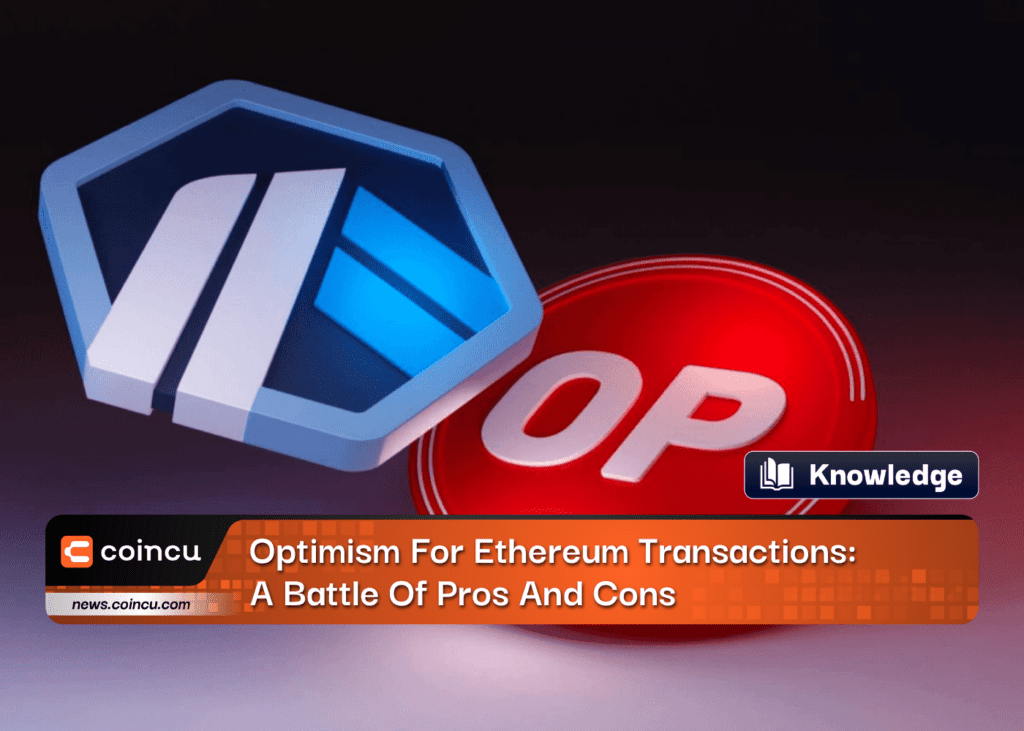Optimistic rollups are an approach to scaling Ethereum that involves moving computation and state storage off-chain. Optimistic rollups aim to reduce the fees associated with Ethereum transactions while maintaining the security and trustlessness of the blockchain. This post will explore the pros and cons of using optimism for Ethereum transactions.
Introduction

What Is Optimistic Rollup?
Optimism is “Optimistic Rollup,” which is basically a fancy way of describing a blockchain that piggybacks off of the security of another “parent” blockchain. Specifically, Optimistic Rollups take advantage of their parent chain’s consensus mechanism (like PoW or PoS) instead of providing their own. In Optimism’s case, this parent blockchain is Ethereum.

Optimistic rollup is a scaling solution for Ethereum that allow for off-chain computation and state storage. This means that instead of executing transactions on the Ethereum blockchain, they are executed off-chain and posted to the Ethereum mainnet in batches. This approach has several benefits, including reduced fees for end-users and the ability to process more transactions per second than the Ethereum blockchain can handle on its own.
How Do Optimistic Rollups Work?
Transaction Execution and Aggregation
Users submit transactions to validators, also known as aggregators, who process the transactions on the optimistic rollup. Unlike on-chain transactions, which can be prohibitively expensive due to high gas fees, optimistic rollups are able to process multiple transactions at once. The validators then compress the data generated by these transactions into one batch, which is then published on the Ethereum mainnet.
State Commitments and Fraud Proving
Every state transition on the optimistic rollup chain produces a new state, which the operator commits to by computing a new state root. This state root is hashed and stored in the rollup contract. Additionally, the operator commits a Merkle root for the transaction batch itself, which allows anyone to prove the inclusion of a transaction in the batch by presenting a Merkle proof.
However, optimistic rollups do not publish cryptographic proofs of validity for off-chain transactions. Instead, they assume that off-chain transactions are valid and rely on a fraud-proving scheme to detect cases where transactions are not calculated correctly. After a rollup batch is submitted on Ethereum, there is a time window called a challenging period during which anyone can challenge the results of a rollup transaction by computing a fraud-proof.
If the fraud-proof succeeds, the rollup protocol re-executes the transaction(s) and updates the rollup’s state accordingly. The other effect of successful fraud-proof is that the sequencer responsible for including the incorrectly executed transaction in a block receives a penalty.
L1/L2 Interoperability
Optimistic rollups are designed for interoperability with Ethereum Mainnet and allow users to pass messages and arbitrary data between L1 and L2. They are also compatible with the Ethereum Virtual Machine (EVM), so you can port existing dapps to optimistic rollups or create new dapps using Ethereum development tools.
Asset Movement
Users deposit ETH, ERC-20 tokens, and other accepted assets in the rollup’s bridge contract on L1 to use an optimistic rollup. The bridge contract then relays the transaction to L2, where an equivalent amount of assets is minted and sent to the user’s chosen address on the optimistic rollup. Withdrawing from an optimistic rollup to Ethereum is more difficult due to the fraud-proving scheme. If a user initiates an L2 > L1 transaction to withdraw funds escrowed on L1, they must wait until the challenge period, which lasts approximately seven days, elapses.
Multi-Round Interactive Proving
Optimistic rollups are switching to multi-round interactive proving, achieving the same objective of detecting invalid rollup operations more efficiently. Multi-round interactive proving involves a back-and-forth protocol between the asserter and challenger overseen by an L1 verifier contract, which ultimately decides the lying party. After an L2 node challenges an assertion, the asserter is required to divide the disputed assertion into two equal halves. Each individual assertion in this case will contain as many steps of computation as the other.
The challenger will then choose what assertion it wants to challenge. The dividing process, called a bisection protocol, continues until both parties are disputing an assertion about a single step of execution. At this point, the L1 contract will resolve the dispute by evaluating the instruction (and its result) to catch the fraudulent party.
Pros and Cons of Using Optimism
| Pros | Cons |
| Reduced Fees | Limited Smart Contract Functionality |
| Scalability | Longer Withdrawal Times |
| Compatibility with Ethereum | Security Risks |
| Trustless Finality | |
| Improved Security |
Pros
Reduced Fees
One of the primary benefits of using optimistic rollups is the reduction in fees associated with Ethereum transactions. Optimistic rollup operators bundle multiple off-chain transactions in large batches before submitting them to Ethereum. By spreading fixed costs across multiple transactions in each batch, fees for end-users are reduced.
Scalability
Another advantage of optimistic rollups is improved scalability. Since computation and state storage are moved off-chain, the Ethereum network can process more transactions per second. This is important as Ethereum continues to grow and attract more users.
Compatibility with Ethereum
Optimistic rollups are designed to operate on top of Ethereum, making them compatible with the Ethereum ecosystem. This means that developers can migrate existing smart contracts on Ethereum to optimistic rollup chains without extensively modifying codebases. Additionally, developers and project teams using optimistic rollups can take advantage of Ethereum’s infrastructure, such as programming languages, code libraries, testing tools, client software, deployment infrastructure, and more.
Trustless Finality
Optimistic rollups provide trustless finality, which guarantees that a transaction, so long as it’s valid, will eventually be confirmed. Fraud proofs are important because they facilitate trustless finality in optimistic rollups. Trustless finality is a quality of optimistic rollups that guarantees that a transaction—so long as it’s valid—will eventually be confirmed.
Improved Security
Optimistic rollups rely on the main Ethereum protocol for data availability, censorship resistance, and settlement. This makes optimistic rollups more secure than pure off-chain scaling protocols like sidechains that do not rely on Ethereum for security.
Cons
Limited Smart Contract Functionality
One of the primary drawbacks of optimistic rollups is their limited smart contract functionality. Although optimistic rollups are compatible with the Ethereum ecosystem, they cannot support all the features and functions of the Ethereum blockchain. This is because optimistic rollups execute transactions outside of Ethereum but post transaction data to Mainnet as calldata.
Longer Withdrawal Times
Withdrawing from an optimistic rollup to Ethereum is more difficult owing to the fraud-proving scheme. If a user initiates an L2 > L1 transaction to withdraw funds escrowed on L1, they must wait until the challenge period—roughly seven days—elapses. This makes the withdrawal process longer and more cumbersome than traditional Ethereum transactions.
Security Risks
Optimistic rollups rely on the assumption that off-chain transactions are valid and do not publish proofs of validity for transaction batches posted on-chain. This separates optimistic rollups from zero-knowledge rollups that publish cryptographic proofs of validity for off-chain transactions. Optimistic rollups rely on a fraud-proving scheme to detect cases where transactions are incorrectly calculated. While this scheme works in theory, there is always a risk of malicious actors exploiting vulnerabilities in the system.
Conclusion
Optimistic rollups offer many benefits for Ethereum transactions, including reduced fees, improved scalability, compatibility with Ethereum, trustless finality, and improved security. However, there are drawbacks, such as limited smart contract functionality, longer withdrawal times, and security risks. Optimistic rollups are a promising solution for scaling Ethereum, but they are not without challenges like any technology. As Ethereum continues to grow and attract more users, it will be interesting to see how optimistic rollups evolve and adapt to meet the needs of the community.
DISCLAIMER: The Information on this website is provided as general market commentary and does not constitute investment advice. We encourage you to do your own research before investing.
Join us to keep track of news: https://linktr.ee/coincu
Thana
Coincu News





